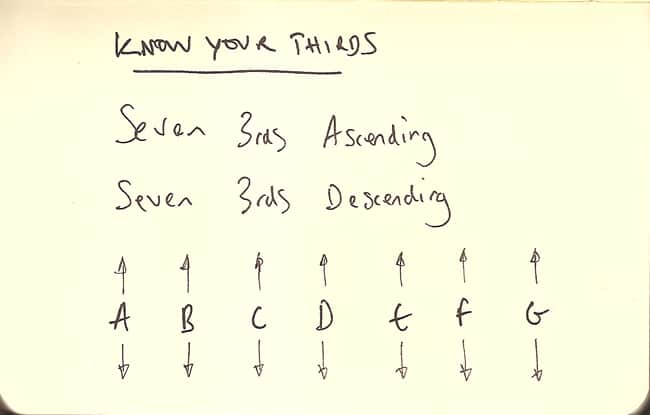There are only seven thirds (ascending) that you need to know:
A – C
B – D
C – E
D – F
E – G
F – A
G – B
Also, learn them descending, so that’s another seven :)
A – F
B – G
C – A
D – B
E – C
F – D
G – E
A to C (ascending) is always a third.
Whatever the A is; whatever the C is.
A – C#
Ab – Cb
Abb – C#
Abbbbb – Cbbbbb
A########### – C######bb#
A#¢®†§¶¨- C§¥•^¨øπ
These are all thirds.
So, A to C is a third, but what kind of third?
Here are the types of thirds in order of size. (not sure if size is a good way to describe pitch, but I hope you get what I mean)
Diminished Third: A to Cb
Minor Third: A to C
Major Third: A to C#
Augmented Third: A to C## (there’s a little symbol for a ‘double sharp’ that’s like an ‘x’, but I don’t have the font on my machine)
Technically you could have A to Cbb – a doubly diminished third; likewise, A to C### – a doubly augmented third, but you’d be living a lonely existence :)
Knowing how to notate thirds accurately, (and other intervals) depends on upon your knowledge of the major scale.
If you know that in every key, then you’ll be able to name the intervals correctly.
Anyway, hopefully, you’ll be able to see that A to C of any kind is a third.
A to B is not, and never will be, a third.
It is, and always will be, a second (of some type).
Don’t fall into the trap of calling, say, C# to F a third. You mean Db to F. It’s a super common error amongst guitarists.
Why?
Because of TAB, of relying on shapes and not thinking about the notes.
Why is this useful?
Say you’ve got these notes: C# F Ab C.
What chord is that?
You can run into all kinds of bother trying to label a chord when you’ve spelt a note incorrectly.
The C# should be Db.
Then you can see that it’s a bunch of 3rds and all is well with the universe.
Anyhow, the point of this is to know those seven thirds at the beginning of the lesson.
That’s a HUGE HUGE key to understanding harmony and everything.
It really is.
